第三部分-常用句型句式
- 格式:doc
- 大小:33.00 KB
- 文档页数:5
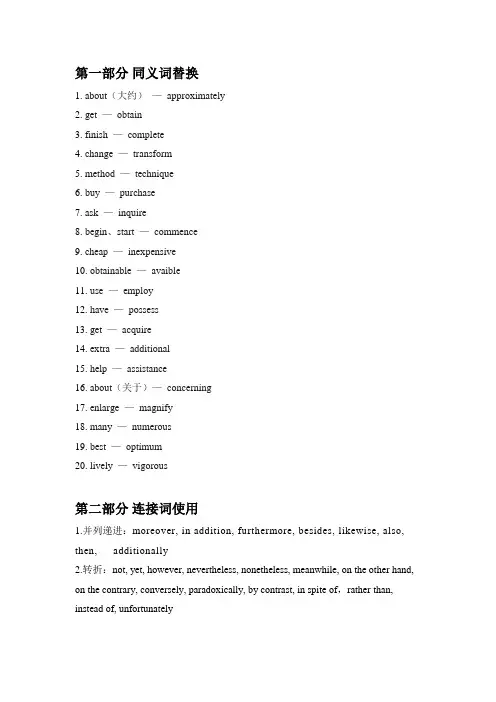
第一部分同义词替换1. about(大约)—approximately2. get —obtain3. finish —complete4. change —transform5. method —technique6. buy —purchase7. ask —inquire8. begin、start —commence9. cheap —inexpensive10. obtainable —avaible11. use —employ12. have —possess13. get —acquire14. extra —additional15. help —assistance16. about(关于)—concerning17. enlarge —magnify18. many —numerous19. best —optimum20. lively —vigorous第二部分连接词使用1.并列递进:moreover, in addition, furthermore, besides, likewise, also, then, additionally2.转折:not, yet, however, nevertheless, nonetheless, meanwhile, on the other hand, on the contrary, conversely, paradoxically, by contrast, in spite of,rather than, instead of, unfortunately3.解释:in other words, in fact, as a matter of fact, that is, namely, in simpler terms4.原因:because, because of, as, since, owing to, due to, thanks to, for this reason5.举例:for example, for instance, as such, such as, take ...for example, to illustrate, to name a few6.强调:surprisingly, interestingly,intriguingly, strikingly, unexpectedly, clearly, obviously, apparently,in fact, indeed, actually, as a matter of fact, undoubtedly7.可能:presumably, probably, perhaps8.让步:although, after all, in spite of..., despite, even if, even though, though, admittedly, given that9.总结:overall, eventually, consequently, in summary, in a word, as a result, together, collectively, thus, hence, consequently, on the whole, in conclusion, to sum up, in brief, to conclude, to summarize, in short, briefly10.结果:therefore, as a result, then, consequently, thus, hence, so, therefore, accordingly, consequently, as consequence11. 对比比较:likewise, similarly, in parallel to, while, whereas第三部分常用句式1. 说明选题的重要性:X is the main / leading / primary / major cause of ..Xs are a common / useful / critical part of...Xs are among the most widely used / commonly discussed / well-known / well-documented / widespread/commonly investigated types of ...X is recognized as being / believed to be / widely considered to be the most important ...It is well known / generally accepted / common knowledge that X is (X)is increasingly becoming / set to become a vital factor in …Xs are undergoing a revolution / generating considerable interest in terms of …Xs are attracting considerable / increasing / widespread interest due to …2. 概述前人做过的研究:Last century X was considered to be / viewed as / seen as the most …Initial / Preliminary / The first studies of X considered it tobe...Tradition ally X / In the history of X, the focus has always been …Scientists / Researchers / Experts have always seen X as …Until now / For many years / Since 1993 Xs have been considered as …X has received much attention in the last two years / in the past decade / over the last two decades …For the past five years / Since 2011 there has been a rapid rise in the use of XsThe last two years have witnessed / seen a huge growth in X …The past decade / last year has seen a renewed importance in X …Recent developments in / findings regarding X have led to …X has become a central / an important / a critical issue in …3. 展望未来:The next decade is likely to see / witness a considerable rise in XIn the next few years X will become / is likely to have becomeWithin the next few years, X is set / destined / likely to become an important component in …By 2025 / Within the next ten years, X will have become …X will soon / shortly / rapidly / inevitably be an issue that …4. 指出知识上的空缺:Few researchers have addressed the problem / issue / question of …Previous work has only focused on / been limited to / failed to address …The central / core problem ofA challenging / An intriguing / An important / A neglected area in the field of...The characteristics of X are not well understood / are misunderstood / have not been dealt with in depth.It is not yet known / has not yet been established whether X can do Y. X is still poorly / not widelyunderstood.Techniques to solve X are computationally demanding / subject to high overheads / time consuming / impractical / frequently unfeasible.A major defect / difficulty / drawback / disadvantage / flaw of X is …One of the main issues in our knowledge of / what we know about X is a lack of …This particular / specific area of X has been overlooked / has b een neglected / remains unclear …Despite this interest, no one to the best of our knowledge / as far as we know has studied …Although this approach is interesting, it suffers from / fails to take into account / does not allow for…However, there is still a need for / has been little discussion on …Moreover, other solutions / research programs / approaches have failed to provide...There is stillsome / much / considerable controversy surrounding …Concerns have arisen / been raised which question / call into q uestion the validity of …In the light of recent events in x, there is now some / much / considerable concern about …5. 论述论文目标和贡献:In this report / paper / review / study we …This paper outlines / proposes / describes / presents a new approach to …This pape r examines / seeks to address / focuses on / discusses / investigates how to solve …This paper is an overview of / a review of / a report on / a preliminary attempt to ...The present paper aims to validate / call into question / refute Peng’s findings regarding …X is presented / described / analyzed / computed / investigated / examined / introduced / discussed in order to …The aim of our work / research / study / analysis was to further / extend / widen / broaden current knowledge of …The aim of this study is to study / evaluate / validate / determine / examine / analyze / calculate / estimate / formulate …This paper calls into question / takes a new look at / re-examines / revisits / sheds new light on …We undertook this study / initiated this research / de veloped this methodology to...We believe that we have found / developed / discovered / designed an innovative solution to …We describe / present / consider / analyze a novel / simple / radical / interesting solution for …。
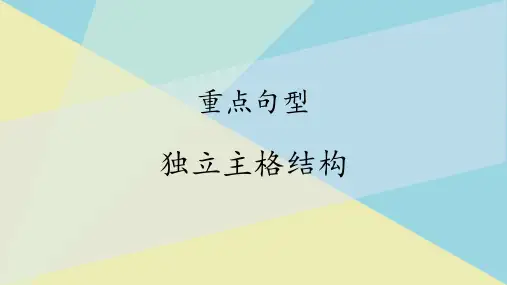

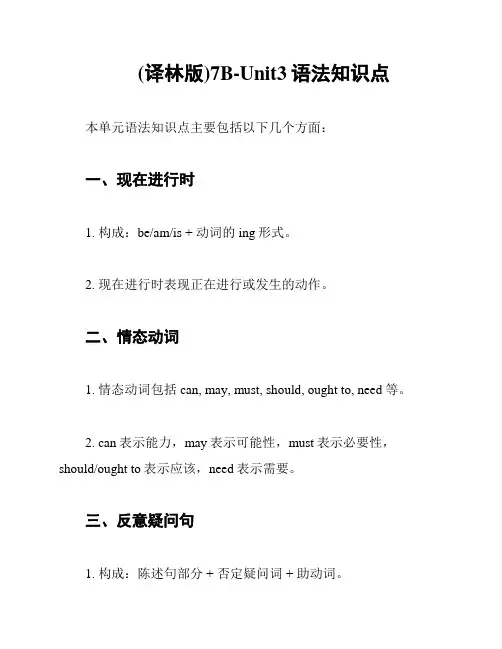
(译林版)7B-Unit3语法知识点
本单元语法知识点主要包括以下几个方面:
一、现在进行时
1. 构成:be/am/is + 动词的ing形式。
2. 现在进行时表现正在进行或发生的动作。
二、情态动词
1. 情态动词包括 can, may, must, should, ought to, need等。
2. can表示能力,may表示可能性,must表示必要性,should/ought to表示应该,need表示需要。
三、反意疑问句
1. 构成:陈述句部分 + 否定疑问词 + 助动词。
2. 如果陈述句为肯定句,则反意疑问句为否定形式;如果陈述句为否定句,则反意疑问句为肯定形式。
3. 当陈述句中含有情态动词时,反意疑问句中的助动词要和情态动词保持一致。
四、一般现在时和现在进行时的区别
1. 一般现在时表示经常或惯性发生的动作或状态。
2. 现在进行时表示正在进行或发生的动作。
五、动词不定式
1. 构成:to + 动词原形。
2. 动词不定式可以作主语、宾语、表语、定语、状语等。
以上是本单元的语法知识点总结,希望同学们认真学习,多做练习,提高英语语言运用能力。
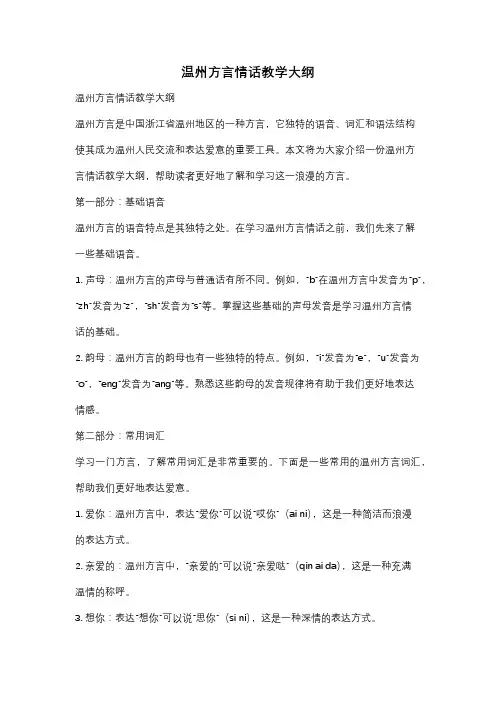
温州方言情话教学大纲温州方言情话教学大纲温州方言是中国浙江省温州地区的一种方言,它独特的语音、词汇和语法结构使其成为温州人民交流和表达爱意的重要工具。
本文将为大家介绍一份温州方言情话教学大纲,帮助读者更好地了解和学习这一浪漫的方言。
第一部分:基础语音温州方言的语音特点是其独特之处。
在学习温州方言情话之前,我们先来了解一些基础语音。
1. 声母:温州方言的声母与普通话有所不同。
例如,“b”在温州方言中发音为“p”,“zh”发音为“z”,“sh”发音为“s”等。
掌握这些基础的声母发音是学习温州方言情话的基础。
2. 韵母:温州方言的韵母也有一些独特的特点。
例如,“i”发音为“e”,“u”发音为“o”,“eng”发音为“ang”等。
熟悉这些韵母的发音规律将有助于我们更好地表达情感。
第二部分:常用词汇学习一门方言,了解常用词汇是非常重要的。
下面是一些常用的温州方言词汇,帮助我们更好地表达爱意。
1. 爱你:温州方言中,表达“爱你”可以说“哎你”(ai ni),这是一种简洁而浪漫的表达方式。
2. 亲爱的:温州方言中,“亲爱的”可以说“亲爱哒”(qin ai da),这是一种充满温情的称呼。
3. 想你:表达“想你”可以说“思你”(si ni),这是一种深情的表达方式。
4. 你好漂亮:温州方言中,“你好漂亮”可以说“你好靓啊”(ni hao liang a),这是一种赞美女性的方式。
第三部分:常用句型除了词汇外,温州方言中的常用句型也是我们学习的重点。
下面是一些常用的温州方言句型,帮助我们更好地表达情感。
1. 我好喜欢你:温州方言中,“我好喜欢你”可以说“我好钟意你”(wo hao zhong yi ni),这是一种直接而真挚的表达方式。
2. 你是我心中的唯一:表达“你是我心中的唯一”可以说“你是我心里嘅独一无二”(ni shi wo xin li de du yi wu er),这是一种浪漫而深情的表达方式。
3. 你的微笑让我心动:温州方言中,“你的微笑让我心动”可以说“你个笑容勾动我心”(ni ge xiao rong gou dong wo xin),这是一种甜蜜而动人的表达方式。
![[荐]人教九年级英语上Unit3单词、知识梳理、词汇句式精讲](https://uimg.taocdn.com/28b67d459b89680203d825d4.webp)
人教九年级英语上Unit3单词、知识梳理、词汇句式精讲一、单词restroom [ˈrestru:m] n.(美)洗手间;公共厕所stamp [stæmp] n. 邮票;印章bookstore [ˈbukstɔ:(r)] n. 书店beside[bɪˈsaɪd] prep. 在……旁边;在……附近postcard [ˈpəustka:(r)d] n. 明信片pardon [ˈpa:(r)dn] v. 原谅interj.请再说一遍washroom [ˈwɔʃru:m] n. 洗手间;厕所bathroom [ˈbɑ:θru:m] n. 浴室;洗手间normally ['nɔ:rməli] adv.通常;正常情况下rush [rʌʃ] v. & n. 仓促;急促suggest [səˈdʒest] v. 建议;提议pass by 路过;经过staff [sta:f] n. 管理人员;职工grape [greip] n. 葡萄central [ˈsentrəl] adj. 中心的;中央的Nearby [ˌnɪrˈbaɪ] adj.附近的;邻近的adv.在附近;附近Pardon me 抱歉, 对不起;什么,请再说一遍mail [meil] v. 邮寄;发电子邮件n. 邮件east [i:st] adj. 东方的;东部的adv.向东;n.东方fascinating [ˈfæsineitiŋ] adj.迷人的;有吸引力的. Inexpensive[ˌɪnɪkˈspensɪv] adj.不昂贵的Uncrowded [ʌnˈkraʊdɪd] adj.不拥挤的;人少的convenient [kənˈvi:niənt] adj. 便利的;方便的mall [mɔ:l] n. 商场;购物中心clerk [kla:k][kl:rk] n. 职员corner [ˈkɔ:(r)nə(r)] n. 拐角;角落politely [pəˈlaitli] adv. 礼貌地;客气地request [riˈkwest] n. 要求;请求direction [diˈrekʃn] [daiˈrekʃn] n. 方向;方位correct [kəˈrekt] adj. 正确的;恰当的polite [pəˈlait] adj. 有礼貌的;客气的. direct [diˈrekt, daiˈrekt] adj. 直接的;直率的. speaker [ˈspi:kə] n.讲(某种语言)的人;发言者whom [hu:m] pron. 谁;什么人impolite [ˌɪmpəˈlaɪt] adj. 不礼貌的;粗鲁的address [əˈdres], [ˈædres] n.住址;地址;通讯处. Underground [ˈʌndəɡraʊnd] adj.地下的;n.地铁Parking lot n.停车场course [kɔ:(r)s] n. 课程;学科Italian [Iˈtæli ən] adj.意大利\人的;n.意大利人\语Tim [tim] 蒂姆(男名)二、Unit3 知识梳理Unit3 Could you please tell me where ....【重点短语】1.a pair of 一对,一双,一副2.between A and B 在a和b之间3.on one’s / the way to 再去……的路上4.pardon me 什么,请再说一遍5.pass by 路过经过6.look forward to 盼望期待7.excuse me 打扰了请原谅8.get some information about获取有关……的一些信息9.turn left\right 向左\向右转10.go past 经过路过11.a little earlier 早一点儿12.a good place to eat 一个吃饭的好地方13.in different situation 在不同的情况下14.on time 准时按时15.get to 到达16.have dinner 吃晚餐17.on one’s / \the right在右边e on 快点请过来19.the shopping center 购物中心20.the corner of....... 的角落/拐角处21.lead into 导入,引入【重点句型】1.问路常用的句子:①Do you know where is …?②Can you tell me how can I get to …?③Could you tell me how to get to …?④Could/Will/Would you please tell me sth. 表示十分客气地询问事情Could you tell me how to get to the park? 请你告诉我怎么才能去邮局好吗?2. decide to do 决定做…...She decided to go to have lunch.她决定去吃午餐。
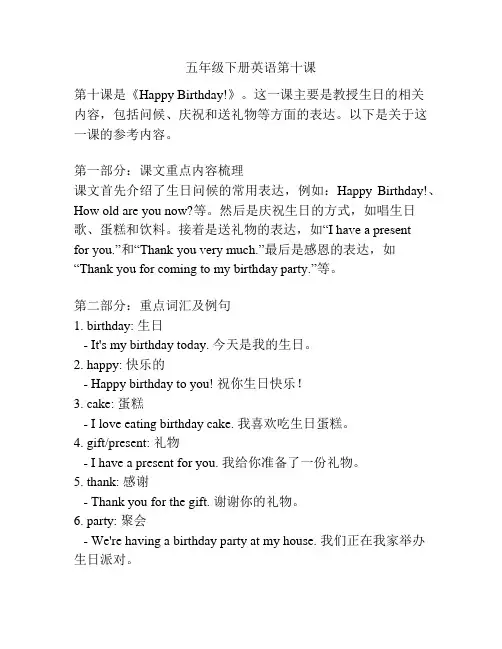
五年级下册英语第十课第十课是《Happy Birthday!》。
这一课主要是教授生日的相关内容,包括问候、庆祝和送礼物等方面的表达。
以下是关于这一课的参考内容。
第一部分:课文重点内容梳理课文首先介绍了生日问候的常用表达,例如:Happy Birthday!、How old are you now?等。
然后是庆祝生日的方式,如唱生日歌、蛋糕和饮料。
接着是送礼物的表达,如“I have a presentfor you.”和“Thank you very much.”最后是感恩的表达,如“Thank you for coming to my birthday party.”等。
第二部分:重点词汇及例句1. birthday: 生日- It's my birthday today. 今天是我的生日。
2. happy: 快乐的- Happy birthday to you! 祝你生日快乐!3. cake: 蛋糕- I love eating birthday cake. 我喜欢吃生日蛋糕。
4. gift/present: 礼物- I have a present for you. 我给你准备了一份礼物。
5. thank: 感谢- Thank you for the gift. 谢谢你的礼物。
6. party: 聚会- We're having a birthday party at my house. 我们正在我家举办生日派对。
第三部分:常用句型及例句1. How old are you now? 你现在多大了?- I'm ten years old. 我十岁了。
2. Happy Birthday! 祝你生日快乐!- Thank you! 谢谢你!3. I have a present for you. 我给你准备了一份礼物。
- Thank you very much. 非常感谢你。
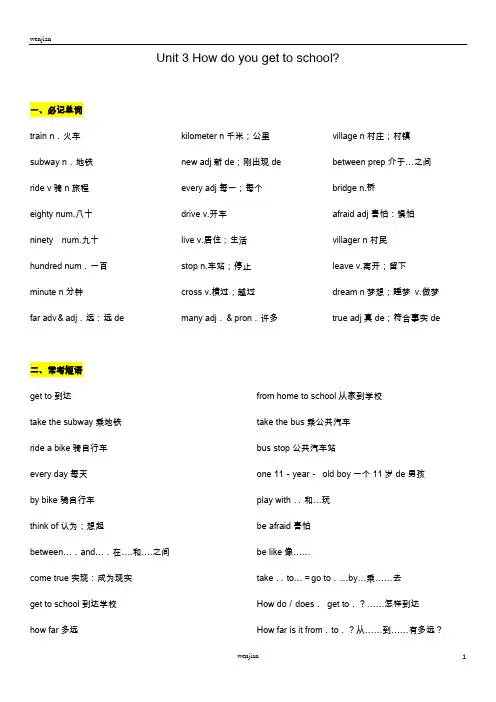
Unit 3 How do you get to school?一、必记单词train n.火车subway n.地铁ride v骑n旅程eighty num.八十ninety num.九十hundred num.一百minute n分钟far adv&adj.远:远de kilometer n千米;公里new adj新de;刚出现deevery adj每一;每个drive v.开车live v.居住;生活stop n.车站;停止cross v.横过;越过many adj.&pron.许多village n村庄;村镇between prep介于…之间bridge n.桥afraid adj害怕:惧怕villager n村民leave v.离开;留下dream n梦想;睡梦v.做梦true adj真de;符合事实de二、常考短语get to到达take the subway乘地铁ride a bike骑自行车every day每天by bike骑自行车think of认为;想起between….and….在….和….之间come true实现:成为现实get to school到达学校how far多远from home to school从家到学校take the bus乘公共汽车bus stop公共汽车站one 11-year-old boy一个11岁de男孩play with..和…玩be afraid害怕be like像……take..to…=go to.…by…乘……去How do/does.get to.?……怎样到达How far is it from.to.?从……到……有多远?It takes sb.some time to do sth.做某事花费某人多少时间。
How long does it take.?…花费多长时间?It is+adj+to do sth.做某事是…de。
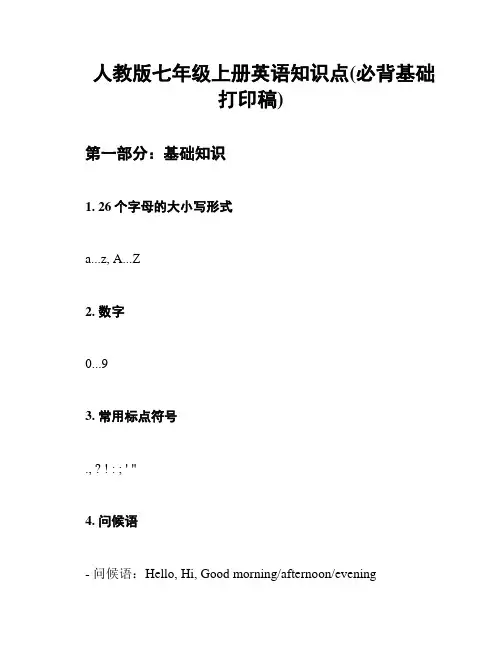
人教版七年级上册英语知识点(必背基础打印稿)第一部分:基础知识1. 26个字母的大小写形式a...z, A...Z2. 数字0 (9)3. 常用标点符号., ? ! : ; ' "4. 问候语- 问候语:Hello, Hi, Good morning/afternoon/evening- 道别语:Bye, Goodbye, See you later 5. 介绍自己My name is ..., I'm ... years old. I'm from ... 第二部分:日常用语1. 问候与感谢- 问候:How are you? Fine, thank you. 2. 询问和回答- How do you spell it? C-A-T.- What's this in English? It's a ...3. 询问时间和时间回答- What time is it? It's ... o'clock.- What's the time? It's ... o'clock.4. 日常用语- Excuse me, Sorry, Can I help you?第三部分:语法与句型1. 动词to be- be动词的用法:am, is, are- 肯定句:I am a student.- 否定句:I'm not a teacher.- 疑问句:Are you a doctor?2. 一般现在时- 现在时动词的变化规则:第三人称单数变化规则(s/es) - 肯定句:He speaks English.- 否定句:He doesn't speak English.- 疑问句:Does he speak English?3. 名词所有格- 物主代词:my, your, his, her- 所有格的形式:用's表示;以s结尾名词加'表示;以s结尾的复数名词后加'- 例句:That's my brother's pen.4. 人称代词- 主人称:I, you, he, she, it, we, they- 宾格:me, you, him, her, it, us, them- 物主代词:my, your, his, her, its, our, their第四部分:常用句型和表达1. 常用简单句式- 主语+谓语:I am a student.- 陈述句:He plays basketball every day.- 疑问句:Do you like music?- 否定句:I do not have a pen.2. 介绍家庭成员- This is my family.- I have a father/mother/sister/brother.3. 描述人物特征和爱好- 物品颜色、大小、形状;人物身高、体重、年龄;爱好、技能、爱好。
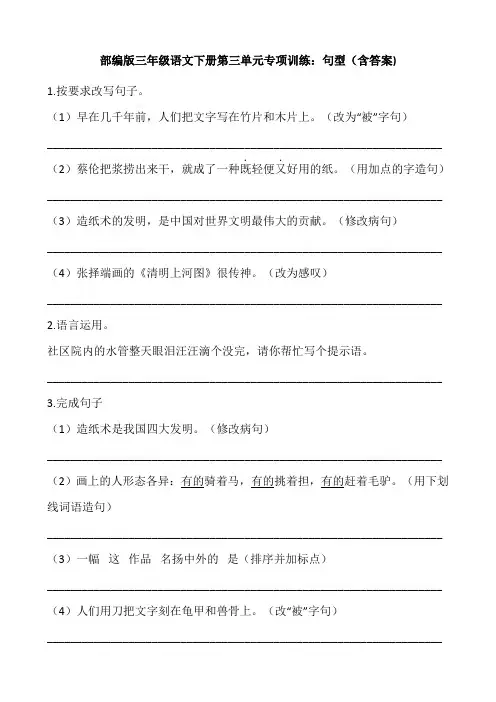
部编版三年级语文下册第三单元专项训练:句型(含答案)1.按要求改写句子。
(1)早在几千年前,人们把文字写在竹片和木片上。
(改为“被”字句) ____________________________________________________________________(2)蔡伦把浆捞出来干,就成了一种既.轻便又.好用的纸。
(用加点的字造句) ____________________________________________________________________ (3)造纸术的发明,是中国对世界文明最伟大的贡献。
(修改病句) ____________________________________________________________________ (4)张择端画的《清明上河图》很传神。
(改为感叹)____________________________________________________________________ 2.语言运用。
社区院内的水管整天眼泪汪汪滴个没完,请你帮忙写个提示语。
____________________________________________________________________ 3.完成句子(1)造纸术是我国四大发明。
(修改病句)____________________________________________________________________ (2)画上的人形态各异:有的骑着马,有的挑着担,有的赶着毛驴。
(用下划线词语造句)____________________________________________________________________ (3)一幅 这 作品 名扬中外的 是(排序并加标点)____________________________________________________________________ (4)人们用刀把文字刻在龟甲和兽骨上。

Unit 3 —— There be句型及可数名词和不可数名词概念引入一、欣赏含有There be句型的名句1. If there were no clouds, we should not enjoy the sun. 无云焉知太阳暖。
2. Where there’s a will, there’s a way. 有志者事竟成。
3. When there is a family, there is a god. 有家的地方就是天堂。
二、名词名词是表示人,事物和抽象概念的词,在短语或句子中通常可以用代词来替代。
名词可以分为专有名词和普通名词;可数名词和不可数名词等。
用法讲解一、There be句型1. There be句型的意义There be句型常表示某处有某人或某物。
例如:There is a computer in the room. 房间里有一台电脑。
There are two TV plays every evening. 每晚有两场电视剧。
2. There be句型的各种句型结构(1)肯定句:There be+某物/某人+地点/时间状语。
例如:There is a pencil on the desk. 桌子上有一支铅笔。
(2)否定句:There be+not+某物/某人+地点/时间状语。
这个句式的否定形式的构成是将be之后加not,同时,原句中如有some一词,也应改为any。
例如:There is a bird in the tree. 树上有一只鸟。
There isn't any bird in the tree. 树上没有鸟。
There are some children behind the house. 房后有些孩子。
There aren't any children behind the house. 房后没有小孩。
(3)一般疑问句: Be+there+某物/某人+地点/时间状语?这是There be句型的疑问句,其构成是将be动词提到there之前,句尾用问号。
第三部分 写作技能培优第一讲 写好五种基本句型,简单句变得更简单1.(2014·高考新课标全国卷Ⅱ·写作)I 主语will be twenty eight years old 谓语 by then 状语. 句子结构:主语+谓语2.(2014·高考新课标全国卷Ⅰ·写作)I 主语’m looking forward to 谓语your early reply 宾语 . 句子结构:主语+谓语+宾语3.(2014·高考安徽卷·写作)The important thing 主语 is 系动词to learn to control your temper 表语so that you may not do or say anything you will regret 目的状语. 句子结构:主语+系动词+表语4.(2014·高考陕西卷·写作)I 主语 sincerely 状语 wish 谓语 you 间接宾语 a pleasant time with us.直接宾语句子结构:主语+谓语+间接宾语+直接宾语5.(2013·高考浙江卷·写作)The first day I went to high school 状语,I 主语 saw 谓语some of my classmates 宾语 playing table tennis 宾语补足语. 句子结构:主语+谓语+宾语+宾语补足语一、主语(S)+谓语(不及物动词V)此句型中的谓语动词要用不及物动词或相当于不及物动词的动词短语。
本身句意完整,后面不需要宾语,但可以跟作句子状语的副词、介词短语、状语从句。
①The sun rises in the east and sets in the west.太阳东方升起西方落下。
②He has been standing there.他一直站在那里。
Unit 3 Family matters1.Son:(nervously approaching the table) Erm...Dad,can we talk?儿子(战战兢兢地走到桌旁):那个……爸爸,我能和您谈谈吗?2.Sure!You know you can always turn to your dad for a chat.当然可以!你知道你可以随时找爸爸聊天的。
【词汇精讲】“turn to”本身的含义是“转向”,“turn to sb.for help”或是“turn to sb.”则是向某人求助的含义。
3.I want to focus on my band and have a career in music when I leave school.我想把精力放在我的乐队上,毕业后向音乐方向发展。
wyers help people and are respected by others.律师助人,受人尊敬。
5.ignoring Grandfather’s words无视祖父的话【词汇精讲】ignore 意为“忽视,不理”。
6.Yes,and you have found the career that suits your talents.是的,并且你最终找到了适合你才华的事业。
【词汇精讲】suit意为“适合,使适宜”,多表示口味、情况等适合某人的需要。
7..A play is a story performed on a stage.戏剧是在舞台上表演的故事。
【句式剖析】“performed on a stage”是过去分词短语作a story的后置定语。
英语中单独一个词作定语时,多数情况下要放在被修饰词的前面,短语作定语则需要后置;现在分词作定语,常表示该动词和被修饰名词存在逻辑上的主动关系,另外它还可以表示动作正在进行;过去分词作定语时,常表示该动词和被修饰名词存在逻辑上的被动关系,它还可以表示动作的完成。
给老外上中文课课件在给老外上中文课的时候,我们需要精心准备一份专业的课件,以确保教学内容清晰易懂,让学生能够迅速掌握中文知识。
下面是一份适合给老外上中文课的课件示范:第一部分:拼音学习1. 学习拼音的基本概念- 拼音是中文音节文字的书写方式- 通过掌握拼音,能够正确发音并拼写汉字2. 学习拼音的发音规则- 分清轻声、一声、二声、三声- 发音准确、清晰,注意舌头的位置和口型3. 练习拼音发音- 练习常见汉语拼音,如b, p, m, f等- 通过说、听、读、写的综合练习,提高发音准确度第二部分:基础词汇学习1. 日常用语- 问候语:你好、再见、谢谢等- 数字:一、二、三、四等- 时间:今天、明天、昨天等2. 实用口语- 餐厅用语:吃饭、菜单、服务员等- 交通用语:出租车、地铁、公交车等3. 练习基础词汇- 通过图片配词、语境对话等方式,让学生掌握基础词汇的用法 - 激发学生学习兴趣,提高词汇记忆效果第三部分:常用句型学习1. 简单句型- 主谓宾结构:我是学生、你喜欢中国菜等- 时间地点状语的使用:昨天我去了商店、他在家里学习等2. 日常用语句型- 介绍自己:我叫Tom、我来自美国等- 谈论兴趣爱好:我喜欢看电影、我会弹吉他等3. 练习常用句型- 分角色对话、情境练习- 提倡多角度交流,增强学生对句型的理解和运用能力第四部分:文化习俗学习1. 中国传统节日- 春节、中秋节等- 习俗、风俗、传统活动等2. 饮食文化- 中餐特色、餐桌礼仪等- 食材概念、烹饪技巧等3. 生活习惯- 生活方式、工作习惯等- 社交礼仪、人际关系等通过以上课程内容的设计,能够帮助老外更好地了解和学习中文。
希望这份课件能够对您在给老外上中文课时有所帮助,让教学变得更加有效和有趣。
谢谢阅读!。
第三部分常用句型句式一.过渡词语的应用英语写作中,要做到行文连贯自然,很少有不用过渡词语的。
过渡词是指在文章中说明上下或前后句间关系的词或词组,是连接句与句,段与段落关系的纽带,是使文章连贯的主要工具。
在写作过程中恰当地使用过渡词,可以保证段落结构清晰,逻辑合理,自然流畅。
在熟练掌握过渡词的正确用法以后,可以灵活应用各种各样的句型,甚至发挥更为适用的句型。
而实际情况是,由于受汉语影响,很多学生只注重意义的连贯而忽视形式上的接应,结果造成英语句子连绵不断,病句很多且逻辑关系不明确。
因此,写作文时应有意识地运用包括连词在内的过渡词语。
现将常见过渡词句总结如下:根据衔接词本身在文章中起到的作用,主要分为以下四类。
(一)有关用于开篇引出扩展句的词、词组。
at first 最初for one thing..(for another) 首先..(其次)…at present 现在,当今recently 最近currently 目前,最近lately最近in general 一般说来generally speaking 一般地说at the beginning 起初on the one hand..(on the other hand)一方面..(另一方面)to begin with 首先,第一in the first place 首先,第一first of all 首先,第一first(ly)第一to start with 首先,第一on the whole总起来说presently 现在;此刻It goes without saying that…不用说now 现在(二)有关用来承接上文的词、词组。
after/after that/ afterwards 此后consequently 因此;结果after a few days 几天以后for example 例如after a while 过了一会儿for instance 例如also/too 并且;又for this purpose 为了这个目的at any rate 无论如何from now on 从此at the same time 同时furthermore 而且;此外besides 此外in addition 此外by this time 此时in addition to..除..之外certainly 无疑地;当然地in fact 事实上in other words 换句话说similarly 同样地in particular 特别(地)so 所以in the same way 同样地soon 不久incidentally 顺便提一句still 仍然indeed的确then 然后meanwhile 与此同时third(ly) 第三;第三点moreover 而且,此外to start with 首先;第一no doubt 无疑地for another 其次second(ly) 第二;第二点such as 正如obviously 明显地later 后来of course 当然truly 事实上;真实地particularly 特别地what’s more 而且;此外(三)、有关用来表示不同或相反的意见的词、词组。
after all 毕竟fortunately 幸运地all the same 虽然;但是however 然而;无论如何anyway 无论如何in spite of = despite尽管..;虽然..at the same time 可是luckily 幸运地but 但是nevertheless 不过;虽然如此unlike…不像…;和..不同though/although 尽管conversely 相反地no doubt 无疑地in/ by contrast 对比之下on the contrary 相反地even though 即使otherwise 否则nonetheless 尽管如此unfortunately 不幸地still 仍然whereas ..然而..in fact 事实上yet 仍;然而;但是as a matter of fact 事实上especially 特别地(四)、有关用于小结上文或结束本段落的内容的词、词组。
above all 最重要as a result 结果accordingly 于是as has been noted 如前所述as a consequence 因此as I have said如我所述at last 最后therefore 因此at length 最近;终于thus 因此by and large 一般说来to speak frankly 坦白地说briefly 简单扼要地to sum up 总而言之by doing so 如此to summarize 简言之consequently 因此for this reason 所以eventually 最后surely 无疑finally 最后to conclude 总而言之hence 因此no doubt 毫无疑问in brief 简言之undoubtedly 无疑in conclusion 总之,最后truly 的确in short 简言之so 所以in a word 总之obviously显然in sum 总之,简言之certainly 当然地;无疑地in summary 简要地说all in all 总之on the whole 总体来说;整个看来二、应用文常用句型(一)感谢信1.I am grateful/obliged to you for...我非常感谢你的……2.I am greatly indebted to you for what you have done.我为你所做的一切表示感激。
3.I am thankful/obliged to you for your unselfish assistance during… 感谢你在……期间给予我无私的帮助。
4.I deeply appreciate your courtesy and we hope to have the opportunity of rewarding your kindness.我非常感谢你的好意,并希望有机会回报你。
5.I take this opportunity to express my deep appreciation of your kind help you rendered me.我借此机会对你所给予我的帮助表示深深的感谢。
6. It was kind and generous of you to do this for me,and l appreciate it more than l can say.你为我这样做真是太好了,我感激不尽。
7.My appreciate to you for your generous help is beyond my words.I wish I could repay it some day.我无法用言语来表达对你的感激之情。
但愿有朝一日能回报你的帮助。
8.Please accept my most cordial thanks for your timely help,which l will never forget.请接受我诚挚的谢意,感谢你及时的帮助,我将难以忘怀。
9.Words fail me when I want to express my gratitude to you.感激之情难以言表。
10.Again,I would like to express our warm thanks to you.再次向你表示感谢。
(二)道歉信与解释信1.I must apologize to you for... 我必须为……向你道歉。
2.I am terribly/awfully sorry that... 我感到很抱歉,因为……3.It is thoughtless/inconsiderate of me to do... 我做……,实在太欠考虑了。
4.I am afraid what I have done has caused many inconveniences to you. 恐怕我给您添了许多麻烦。
5.I sincerely hope that you can understand that I offended you unintentionally.我真心希望您能理解我并非有意冒犯你的。
6.I regret to inform you that I am unable to do... 我很遗憾地告知您我不能……7.I must make a sincere and humble apology to you for... 我必须为……真诚地向你道歉。
8.Please accept my sincere apology for.., once more. 请再次为……接受我真诚的道歉。
9.I sincerely hope that you will kindly accept my apologies. 我衷心希望你能接受我的道歉。
10.I am so sorry to have put you to so much trouble. 不好意思给你添了很多麻烦。
(三)邀请信1.I am pleased to invite you to participate in …to be held from…to… in… 我很高兴邀请你参加从(日期)到(日期)在……举行的……活动。
2.It is my pleasure/a great honor for me to invite you to…如能邀请你参加……是我莫大的荣幸。
3.It is my pleasure to extend an invitation to you to go traveling with me. 我很高兴邀请你和我一起去旅游。
4.I hope that you won't decline my invitation.我希望你不会拒绝我的邀请。
5.I will cover all the expenses involved.我会负责有关费用。
6.We were wondering if the session could consist of...我们想知道会议是否可以包括……7.Would you please let me know as soon as possible if you can accept my invitation?你能否早日告诉我是否能接受我的邀请?(四)求职信1. I’m writing to explore the possibility of working in your company.2. According to this morning’s Times/China Daily, you want an experienced and efficientsecretary.3. Your advertisement in this morning’s Times/China Daily appeals to me because…. I offer my qualifications in the hope that you will consider me for the job.4. My former associates/employers will tell you that I am neat, accurate and painstaking in my work, that I am tactful and courteous, and that I am resourceful, loyal to the job, and of pleasing personality.5. They will tell you that I am conscientious, that I have an agreeable personality and appearance, and that I get along well with everyone.6. Thank you for your time and consideration.7. I would appreciate the privilege of an interview. I may be reached at the address given above, or by telephone at 32333416.8. I have enclosed a resume as well as a brief sample of my writing for your review. I look forward to meeting with you to discuss further how I could contribute to your organization.9. I would welcome the opportunity for a personal interview with you at your convenience.10. I feel confident that given the opportunity, I can make an immediate contribution to Any Corporation. I would appreciate the opportunity to meet with you to discuss your requirements.(五)投诉信1. I am writing to you to complain about... 我现写信向你投诉有关…2. I am writing to express my dissatisfaction with... 我现写信向你表达对……的不满。